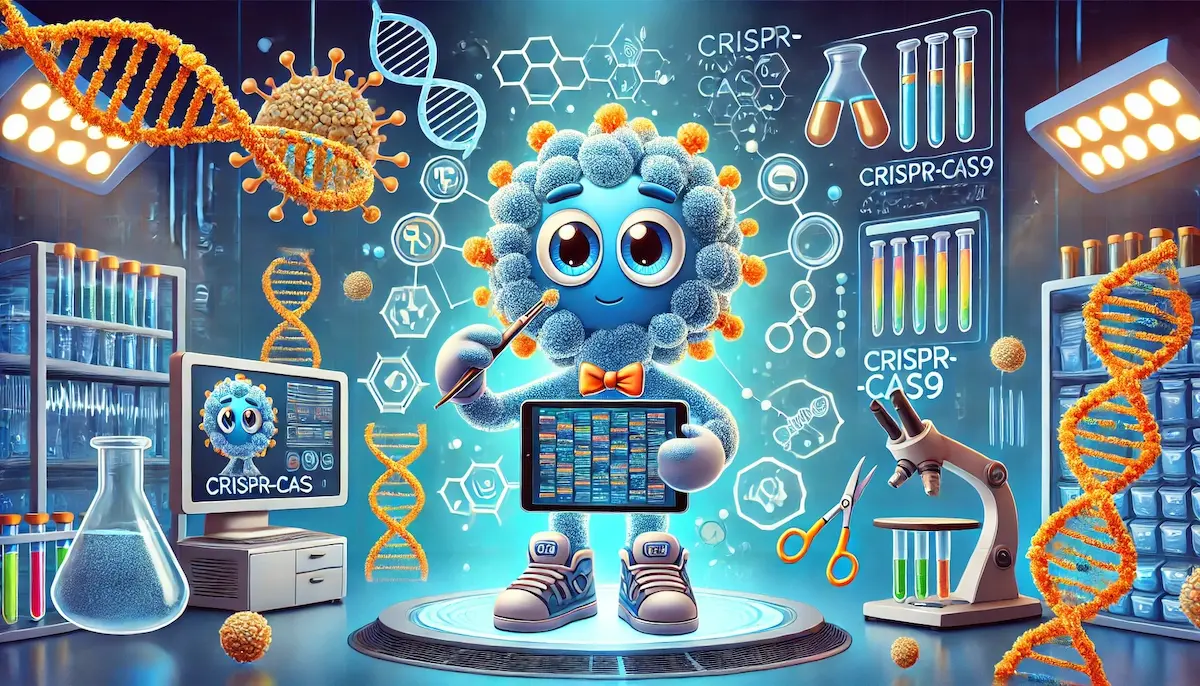CRISPR-Cas9 is a revolutionary gene-editing technology that allows scientists to make precise changes to the DNA of living organisms. This powerful tool has transformed the fields of genetics, medicine, and biotechnology by enabling the targeted modification of genes, opening up possibilities for curing genetic diseases, improving crops, and advancing scientific research. CRISPR-Cas9 is praised for its accuracy, efficiency, and versatility, making it one of the most significant scientific breakthroughs of the 21st century.
The Basics of CRISPR-Cas9
CRISPR-Cas9 is based on a natural defense mechanism found in bacteria. In nature, bacteria use CRISPR (Clustered Regularly Interspaced Short Palindromic Repeats) and associated proteins like Cas9 to defend against viruses by cutting their DNA. Scientists have adapted this system for gene editing, allowing them to target and modify specific DNA sequences in any organism.
Here’s how CRISPR-Cas9 works:
- Guide RNA (gRNA): The process begins with designing a guide RNA, a short RNA sequence that is complementary to the target DNA sequence in the genome. This guide RNA directs the Cas9 enzyme to the exact location in the DNA that needs to be edited.
- Cas9 Enzyme: Cas9 is a protein that acts like molecular scissors. Once the guide RNA finds the target DNA sequence, Cas9 binds to it and makes a precise cut in the DNA.
- DNA Repair: After Cas9 cuts the DNA, the cell’s natural repair mechanisms kick in to fix the break. Scientists can harness this repair process to introduce changes to the DNA—either by disrupting a gene, inserting a new gene, or correcting a mutation.
This ability to precisely target and alter specific genes makes CRISPR-Cas9 a powerful tool for genetic research and therapy.
Applications of CRISPR-Cas9
The applications of CRISPR-Cas9 are vast and transformative, impacting many areas of science and medicine:
Genetic Disease Treatment
One of the most promising applications of CRISPR-Cas9 is in the treatment of genetic diseases. By correcting mutations at the DNA level, CRISPR-Cas9 has the potential to cure inherited disorders. For example, scientists are exploring CRISPR-based therapies for conditions like sickle cell anemia, cystic fibrosis, and muscular dystrophy, where specific genetic mutations cause debilitating symptoms. Early clinical trials are already showing promising results, bringing hope to patients with these previously untreatable conditions.
Cancer Research and Therapy
CRISPR-Cas9 is also revolutionizing cancer research. By editing the genes of immune cells, researchers can create therapies that more effectively target and destroy cancer cells. One such approach is CAR-T cell therapy, where T cells are engineered to recognize and attack cancer cells more efficiently. Additionally, CRISPR-Cas9 is used to study the genetic changes that drive cancer, helping to identify new targets for drug development.
Agriculture and Crop Improvement
In agriculture, CRISPR-Cas9 is being used to develop crops with desirable traits, such as increased yield, resistance to pests and diseases, and improved nutritional content. For example, CRISPR has been used to create rice varieties that are more resistant to flooding, a common problem in many rice-growing regions. This technology is also being used to produce crops with reduced allergenic properties or enhanced nutritional profiles, offering the potential for healthier, more sustainable food sources.
Environmental Applications
CRISPR-Cas9 is being explored for environmental applications, such as controlling invasive species or eradicating disease-carrying pests. For example, scientists are investigating the use of CRISPR to modify the genomes of mosquitoes to prevent them from spreading diseases like malaria and dengue fever. This approach could significantly reduce the burden of these diseases, particularly in regions where they are endemic.
Basic Research
CRISPR-Cas9 is an invaluable tool for basic research, allowing scientists to study the function of specific genes by editing them in model organisms like mice, zebrafish, and fruit flies. This research helps to uncover the roles of genes in development, disease, and other biological processes, providing fundamental insights that drive scientific progress.
Ethical Considerations and Challenges
While CRISPR-Cas9 offers immense potential, it also raises important ethical and safety considerations. The ability to edit the human genome, particularly in ways that could be passed on to future generations, has sparked debates about the ethical implications of germline editing. Concerns include the potential for “designer babies,” unintended consequences of gene editing, and the need for strict regulation and oversight.
Additionally, while CRISPR-Cas9 is highly accurate, it is not perfect. Off-target effects—where the Cas9 enzyme cuts DNA at unintended locations—remain a challenge, though ongoing research is focused on improving the precision and safety of the technology.
The Future of CRISPR-Cas9
The future of CRISPR-Cas9 is incredibly promising, with ongoing advancements likely to expand its applications and improve its effectiveness. Researchers are developing new variants of the Cas9 enzyme with greater specificity and reduced off-target effects. Additionally, the combination of CRISPR-Cas9 with other technologies, such as artificial intelligence and machine learning, is expected to enhance the design of guide RNAs and optimize the gene-editing process.
As CRISPR-Cas9 continues to evolve, it is poised to revolutionize many fields, from medicine and agriculture to environmental science and beyond. The potential to cure genetic diseases, improve food security, and tackle environmental challenges makes CRISPR-Cas9 one of the most exciting and impactful technologies of our time.
Blockfine thanks you for reading and hopes you found this article helpful.
